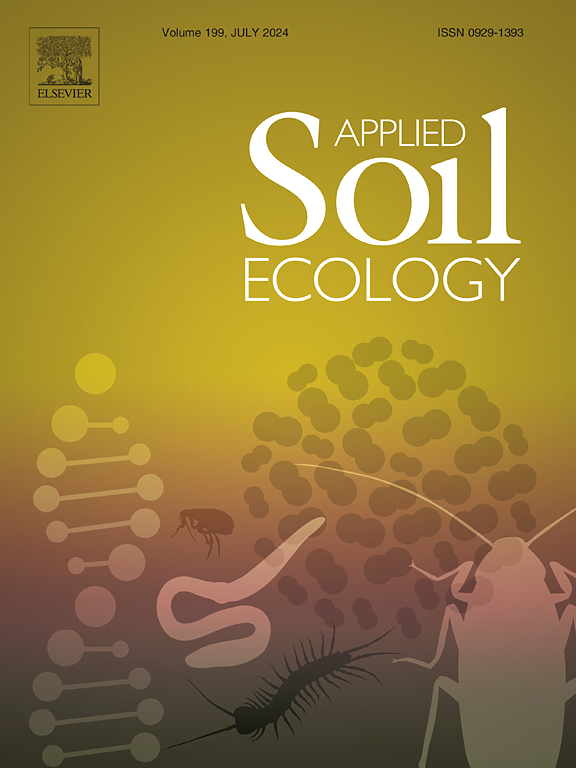Does increased cropping intensity translate into better soil health in dryland wheat systems?
IF 4.8
2区 农林科学
Q1 SOIL SCIENCE
引用次数: 0
Abstract
Despite reliable grain yields, the 13-month fallow period in winter wheat (Triticum aestivum L.) - fallow systems (WF) in low precipitation zones (<350 mm annually) poses several challenges including soil erosion, soil organic matter (SOM) decline, weed management, and overall soil health degradation. Therefore, considerable research efforts are focused on reducing the frequency of fallow and reducing or eliminating tillage. We compared the widely practiced 2-year WF rotation to two 3-year crop rotations with only one year of fallow and continuous annual spring cropping. These systems have been evaluated over the past 10-plus years using undercutter conservation-till and no-till practices in a large-scale and long-term cropping systems experiment near Ritzville, WA USA. To date there is limited research-based information about the influence of these intensified crop rotations using conservation- and no-till compared to traditional conservation-till WF on soil health indicators, particularly microbial activity, and microbial community dynamics in the dryland region of inland Pacific Northwest (iPNW). This study was conducted as a part of Soil Health Institute's North American Project to Evaluate Soil Health Measurements (NAPESHM). We leveraged the aforementioned ongoing long-term (25-year-old) experiment to obtain these data. Soil samples were collected at 0–15 cm depth from different crop rotation treatments that included, 1. winter triticale (X Triticosecale Wittmack)-spring wheat-no till fallow (WT-SW-NTF); 2. continuous annual no-till spring wheat (CSW-NT); 3. winter wheat-undercutter conservation-till fallow (WW-TF); and 4. winter wheat-spring wheat-undercutter conservation-till fallow (WW-SW-TF). Soil samples were analyzed for an array of soil health indicators. Out of the 21 tested soil health indicators, eleven indicators were significantly influenced by crop rotations. These were SOM, carbon mineralization potential (24-h respiration), water extractable carbon (WEC), active C, potentially mineralizable nitrogen (PMN), water extractable nitrogen (WEN), soil pH, NO3-N and NH4-N, phosphatase enzyme activity, and wet aggregate stability (WAS). Within responsive indicators, all C-related biological indicators (SOM, WEC, active C, and 24-h respiration) were highest under WW-SW-TF rotation while N-related indicators (WEN, PMN, and inorganic N) were highest under CSW-NT rotation. The improvements in aforementioned soil properties in the 3-year winter wheat-spring wheat-undercutter conservation-till fallow rotation was likely because of the higher crop biomass production in this rotation as compared to the other tested rotations.
提高种植密度是否能改善旱地小麦系统的土壤健康?
尽管谷物产量可靠,但在低降水量地区(年降水量为 350 毫米),冬小麦(Triticum aestivum L.)-休耕系统(WF)13 个月的休耕期带来了一些挑战,包括土壤侵蚀、土壤有机质(SOM)减少、杂草管理和整体土壤健康退化。因此,大量研究工作都集中在减少休耕频率、减少或取消耕作上。我们将广泛采用的 2 年 WF 轮作与两种 3 年轮作进行了比较,前者只有一年休耕,后者每年春季连续耕作。在过去的 10 多年里,我们在美国华盛顿州里茨维尔附近进行了大规模的长期耕作制度试验,采用犁下保护性耕作和免耕方法对这些耕作制度进行了评估。与传统的保护性耕作 WF 相比,这些采用保护性耕作和免耕的强化轮作对西北太平洋内陆干旱地区(iPNW)的土壤健康指标(尤其是微生物活动)和微生物群落动态的影响方面,迄今为止基于研究的信息还很有限。这项研究是土壤健康研究所北美土壤健康测量评估项目(NAPESHM)的一部分。我们利用上述正在进行的长期(25 年)实验来获取这些数据。我们从不同的轮作处理中采集了 0-15 厘米深的土壤样本,这些处理包括:1.冬三麦(X Triticosecale Wittmack)-春小麦-免耕休耕(WT-SW-NTF);2.连续一年免耕春小麦(CSW-NT);3.冬小麦-割草机保护性耕作休耕(WW-TF);以及 4.冬小麦-春小麦-割草机保护性耕作休耕(WW-SW-TF)。对土壤样本进行了一系列土壤健康指标分析。在检测的 21 项土壤健康指标中,有 11 项指标受到轮作的显著影响。这些指标包括:SOM、碳矿化潜力(24 小时呼吸)、水提取碳(WEC)、活性碳、潜在矿化氮(PMN)、水提取氮(WEN)、土壤 pH 值、NO3-N 和 NH4-N、磷酸酶活性和湿集料稳定性(WAS)。在响应性指标中,所有与碳相关的生物指标(SOM、WEC、活性碳和 24 小时呼吸作用)在 WW-SW-TF 轮作中都是最高的,而与氮相关的指标(WEN、PMN 和无机氮)在 CSW-NT 轮作中是最高的。冬小麦-春小麦-割草机保护性耕作休耕 3 年轮作中上述土壤特性的改善可能是由于与其他测试轮作相比,该轮作的作物生物量产量更高。
本文章由计算机程序翻译,如有差异,请以英文原文为准。
求助全文
约1分钟内获得全文
求助全文
来源期刊

Applied Soil Ecology
农林科学-土壤科学
CiteScore
9.70
自引率
4.20%
发文量
363
审稿时长
5.3 months
期刊介绍:
Applied Soil Ecology addresses the role of soil organisms and their interactions in relation to: sustainability and productivity, nutrient cycling and other soil processes, the maintenance of soil functions, the impact of human activities on soil ecosystems and bio(techno)logical control of soil-inhabiting pests, diseases and weeds.
 求助内容:
求助内容: 应助结果提醒方式:
应助结果提醒方式:


